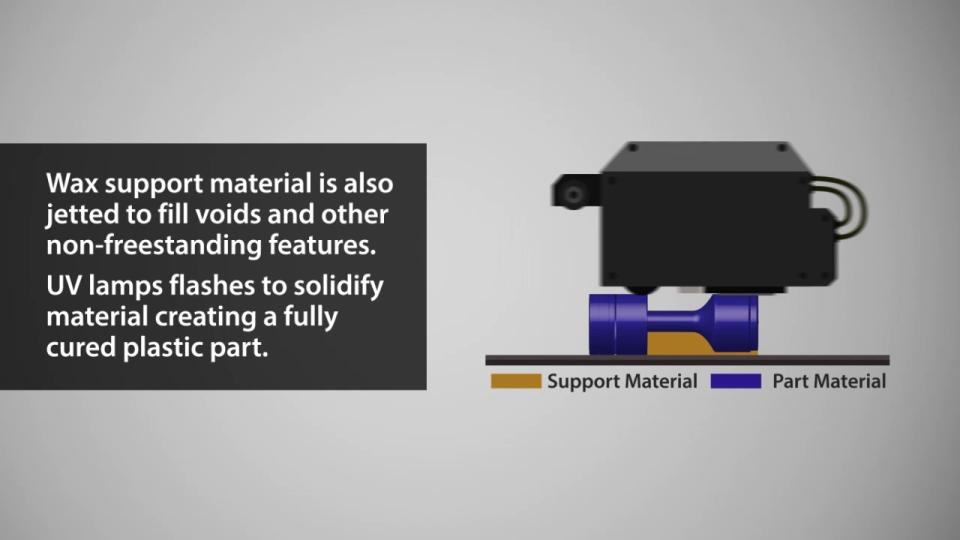With the gain in the popularity of 3D Printing technology, be it for domestic use or industrial purpose, there has been an introduction of various advanced 3D Printing techniques.
Polyjet vs Multijet is a topic sort out by interested people who want to use these technologies to the fullest potential. These incorporate exceptional methods of 3D Printing, thus fabricating remarkable products.
Multijet Fusion Printing and Polyjet technologies are well-known in the market for their accuracy and flexibility in printing objects. In this article, we will be highlighting their techniques, their similarities, their differences and their applications in various fields.
MJP Introduction
Multijet Modeling (MJM), also referred to as Multijet Printing (MJP) is a proprietary technology of 3D Systems. This is an inkjet type of printing process where a print-head technology is used. This print head consists of numerous minute apertures that jet multiple build materials and support materials in the form of droplets, on subsequent layers. The materials used in MJP are photocurable plastic resins or casting wax materials.
 MJP Technology
MJP Technology
With the use of MJP printers, one can get high-quality resolution in the Z-axis with a layer thickness as small as 16 μm. Various delicate parts, complicated internal structures, and other convoluted features of MJP printers can be easily accessed and maintained effortlessly. Recent advancements in the quality of material used, have led to the increased durability of various plastic parts.
PolyJet Introduction
Polyjet (PJ) is a proprietary technology by Stratasys. Its working is similar to that of MJP technology. Polyjet houses an array of tiny nozzles on the print-head. These nozzles eject liquid photopolymer material onto the build platform. With the application of UV light, this photocurable resin material gets cured gradually with simultaneous deposition.

Comparison
The layer thickness in Polyjet is similar to that in MJP technology, i.e., 16 μm. It can vary from 0.0006 inches to 0.0012 inches depending upon the printer, its application area, parts intended to be built, and the material specifications. Due to this precise layer resolution, finer structures, thin-walled parts, complex prototypes, and advanced geometrical structures can be generated with the use of a variety of materials. There is also the advantage of incorporating a wide selection of colors and printing parts in multiple materials in one go.
After thoroughly studying MJP and Polyjet 3D Printing technology, we can clearly understand the similarities and differences between these two. The working methodology of both these technologies is somewhat similar; both use a print-head to deposit the materials. This type of process methodology ensures accuracy and efficiency of the parts being manufactured.
When we move on to the post-processing processes where the support structures are carefully dismembered to get the required geometrical figure, there is remarkable difference between MJP and Polyjet technology. In case of Polyjet technology, the support material is a combination of Propylene, Acrylic monomer, Polyethylene, and Glycerin. The support removal process consists of various steps: Initially, the parts are withdrawn from the build platform. Next, these parts are subjected to a water jet system which is kept under high-pressure condition. At this point, water is sprayed over the parts to remove the maximum amount of support materials keeping in mind not to damage the small, exquisite features of the final parts. After this removal process, the parts are dipped into a chemical solution to remove any leftover support material and to even out rough surfaces.
While this complete process comes in handy for the production of a few quantities of parts, it becomes difficult in case of large batch of products.
On the other hand, Multijet Printing technology has its material for the support structure in the form of paraffin wax. On removal of parts from the bed, they are kept in an oven for the easy melting of the wax support. Although this might be time-consuming, no human effort or continuous guidance is required as the removal process continues on its own.
Once the parts are removed from the oven, one can easily wipe out the remaining wax support material, if any. All these processes in MJP technology are easier and require less effort, as compared to the Polyjet technology.
Thus, it can be said that for the complete part to be ready, both the technologies require a generous amount of time. The only distinction is in case of labor and regular administration, which is a must in Polyjet technology but not in case of Multijet Printing technology. The removal of the wax support structure in case of MJP results in the generation of very fine prints and absence of any application of chemicals for the same.
On conclusion, one can say that since Multijet Printing and Polyjet are proprietary technologies by two of the world’s leading 3D Printing companies in 3D Systems and Stratasys respectively, they are branded differently. But in actuality, they are very similar technologies with slight exception in a few process parameters and support structure removal. To know which technology is better suited for your given application, you can upload your parts on FacFox, or get in touch with our team by writing to info@facfox.com
Add a Comment
You must be logged in to post a comment